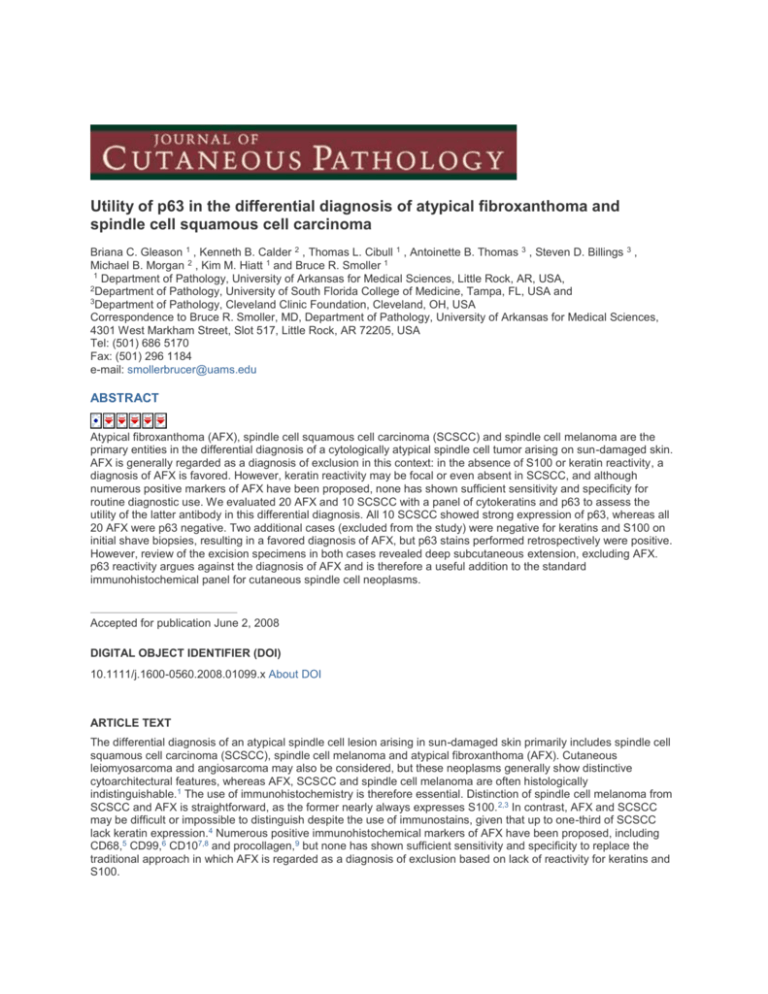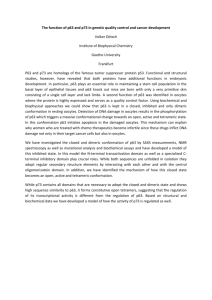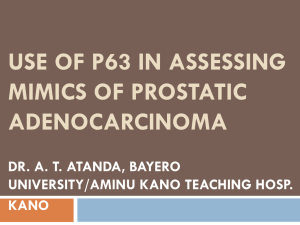Utility of p63 in the differential diagnosis of atypical fibroxanthoma
advertisement

Utility of p63 in the differential diagnosis of atypical fibroxanthoma and spindle cell squamous cell carcinoma Briana C. Gleason 1 , Kenneth B. Calder 2 , Thomas L. Cibull 1 , Antoinette B. Thomas 3 , Steven D. Billings 3 , Michael B. Morgan 2 , Kim M. Hiatt 1 and Bruce R. Smoller 1 1 Department of Pathology, University of Arkansas for Medical Sciences, Little Rock, AR, USA, 2Department of Pathology, University of South Florida College of Medicine, Tampa, FL, USA and 3Department of Pathology, Cleveland Clinic Foundation, Cleveland, OH, USA Correspondence to Bruce R. Smoller, MD, Department of Pathology, University of Arkansas for Medical Sciences, 4301 West Markham Street, Slot 517, Little Rock, AR 72205, USA Tel: (501) 686 5170 Fax: (501) 296 1184 e-mail: smollerbrucer@uams.edu ABSTRACT Atypical fibroxanthoma (AFX), spindle cell squamous cell carcinoma (SCSCC) and spindle cell melanoma are the primary entities in the differential diagnosis of a cytologically atypical spindle cell tumor arising on sun-damaged skin. AFX is generally regarded as a diagnosis of exclusion in this context: in the absence of S100 or keratin reactivity, a diagnosis of AFX is favored. However, keratin reactivity may be focal or even absent in SCSCC, and although numerous positive markers of AFX have been proposed, none has shown sufficient sensitivity and specificity for routine diagnostic use. We evaluated 20 AFX and 10 SCSCC with a panel of cytokeratins and p63 to assess the utility of the latter antibody in this differential diagnosis. All 10 SCSCC showed strong expression of p63, whereas all 20 AFX were p63 negative. Two additional cases (excluded from the study) were negative for keratins and S100 on initial shave biopsies, resulting in a favored diagnosis of AFX, but p63 stains performed retrospectively were positive. However, review of the excision specimens in both cases revealed deep subcutaneous extension, excluding AFX. p63 reactivity argues against the diagnosis of AFX and is therefore a useful addition to the standard immunohistochemical panel for cutaneous spindle cell neoplasms. Accepted for publication June 2, 2008 DIGITAL OBJECT IDENTIFIER (DOI) 10.1111/j.1600-0560.2008.01099.x About DOI ARTICLE TEXT The differential diagnosis of an atypical spindle cell lesion arising in sun-damaged skin primarily includes spindle cell squamous cell carcinoma (SCSCC), spindle cell melanoma and atypical fibroxanthoma (AFX). Cutaneous leiomyosarcoma and angiosarcoma may also be considered, but these neoplasms generally show distinctive cytoarchitectural features, whereas AFX, SCSCC and spindle cell melanoma are often histologically indistinguishable.1 The use of immunohistochemistry is therefore essential. Distinction of spindle cell melanoma from SCSCC and AFX is straightforward, as the former nearly always expresses S100. 2,3 In contrast, AFX and SCSCC may be difficult or impossible to distinguish despite the use of immunostains, given that up to one-third of SCSCC lack keratin expression.4 Numerous positive immunohistochemical markers of AFX have been proposed, including CD68,5 CD99,6 CD107,8 and procollagen,9 but none has shown sufficient sensitivity and specificity to replace the traditional approach in which AFX is regarded as a diagnosis of exclusion based on lack of reactivity for keratins and S100. p63, a transcription factor essential for maintaining the proliferative capacity of epidermal stem cells,10 is normally expressed in keratinocytes of the basal and lower spinous layers. Antibodies to p63 are widely used in the identification of poorly differentiated SCC and sarcomatoid carcinomas in a variety of organs, 11–13 and previous studies have shown that p63 is a sensitive marker of cutaneous SCSCC.14,15 p63 is not expressed in normal mesenchymal cells16,17 and is positive in only 2–3% of mesenchymal neoplasms,12,18,19 suggesting that this antibody may be helpful in the distinction between SCSCC and AFX. In this study, we evaluate the expression of p63 in 20 strictly defined AFX and 10 SCSCC to assess its utility in this differential diagnosis. Materials and methods The surgical pathology files of the University of Arkansas for Medical Sciences (UAMS), James A. Haley VA Hospital Tampa (JAHVA) and Cleveland Clinic Foundation, were searched for tumors classified as AFX between 1998 and 2008 that met the following criteria: (i) origin in sun-damaged skin, (ii) complete excision with negative margins (on initial biopsy or a subsequent specimen), (iii) lack of extension into subcutaneous tissue, (iv) lack of reactivity for three keratin antibodies (CK5/6, AE1/AE3 and CAM5.2) or S100 and (v) absence of necrosis, perineural invasion or lymphovascular invasion. Ten cases of SCSCC were retrieved from the files of UAMS and JAHVA for comparison. Clinical data was obtained from review of the patients' electronic medical records. Immunostains for AE1/AE3, CAM5.2, CK5/6, p63 and S100 were performed on all 20 AFX, and immunostains for at least two keratins and p63 were performed on the 10 SCSCC. Appropriate positive and negative controls were run in parallel. Details of the antibodies used in this study are shown in Table 1. Immunoreactivity was graded semiquantitatively as 0, no staining; 1+, < 25% of cells positive; 2+, 25–50% of cells positive and 3+, > 50% of cells positive. Table 1. Panel of antibodies used Antibody Clone Dilution Antigen retrieval Source AE1/AE3 CK5/6 CK8/18 p63 S100 protein AE1+AE3 1 : 200 1 : 700 1 : 50 1 : 600 1 : 3000 10 min protease 10 min protease 10 min protease Pressure cooker None Dako, Carpinteria, CA, USA Dako Becton Dickinson, San Jose, CA, USA Serotec, Raleigh, NC, USA Dako CAM5.2 4A4 Polyclonal This study was approved by the Institutional Review Board of the UAMS. Results The 20 patients with AFX included 17 men and 3 women; age at diagnosis ranged from 62 to 94 years (median 82 years). Nineteen lesions arose on the head and neck (5 ear, 5 scalp, 4 cheek, 4 forehead and 1 neck) and one tumor occurred on the arm. The 10 patients with SCSCC were 9 men and 1 woman with an age range of 72–95 years (median 85 years). Anatomic sites included the head and neck in nine cases (three forehead, two ear, two cheek, one scalp and one nose) and the arm in one case. Clinical follow up was available in 8 of 20 AFX (40%; median follow up 2.75 years) and 3 of 10 SCSCC (33%; median follow up 1.5 years). No patients in either group experienced recurrences or metastases. All 20 AFX were negative for p63 as well as (by definition) all three keratins and S100 (Fig. 1). In two additional cases (ultimately excluded from the study), the diagnosis of AFX was favored on a shave biopsy based on the lack of S100 and keratin reactivity; however, retrospective immunostains for p63 showed strong, diffuse (one case) or multifocal (one case) nuclear reactivity. Interestingly, both cases showed extensive involvement of the subcutaneous tissue with infiltrative margins on re-excision specimens, excluding the diagnosis of AFX. Fig. 1. Representative example of atypical fibroxanthoma showing surface ulceration at low power (A) and fascicles of atypical spindle cells on high power (B). Cytokeratin (CK5/6; C) and p63 (D) were negative in all cases. [Normal View ] All 10 SCSCC were positive for p63 and at least one keratin (Table 2). Nine tumors showed diffuse expression (> 50% of cells) of at least one keratin and p63. The remaining case show very focal reactivity for both CK5/6 and AE1/AE3 (< 5% of tumor cells), while p63 was diffusely positive (Fig. 2). Table 2. Immunohistochemical results in 10 spindle cell squamous cell carcinomas Antibody 0 1+ 2+ 3+ Total+ (%) CK5/6 AE1/AE3 CK8/18* p63 0 0 1 0 1 2 2 0 3 0 2 3 6 8 3 7 10/10 (100) 10/10 (100) 7/8 (88) 10/10 (100) 0, no staining; 1+, < 25% of tumor cells reactive; 2+, 25–50% of tumor cells reactive; 3+, > 50% of tumor cells reactive. *CAM5.2 not performed on two cases. Fig. 2. Representative spindle cell squamous cell carcinoma showing surface ulceration (A) and atypical spindle cells arranged in fascicles (B). In this case, cytokeratin (CK5/6) was positive in only rare, scattered cells (C and D), while p63 showed diffuse reactivity (E and F). [Normal View ] Discussion The histological criteria for the diagnosis of AFX and the perception of its clinical behavior have shifted dramatically over the years. AFX was originally conceived as a pseudosarcomatous reactive or reparative (i.e. non-neoplastic) lesion that arose on sun-damaged skin in elderly patients.20,21 The concept evolved to that of a superficial malignancy with a relationship to so-called 'malignant fibrous histiocytoma' and a low risk of distant metastasis. 22,23 However, the cases of 'metastasizing AFX' had tumor necrosis, lymphovascular invasion and/or infiltrative margins with extension into subcutaneous adipose tissue or skeletal muscle, 23 which were not features of AFX as originally conceived. Gradually, the perception of AFX has returned to that of a clinically benign, solar damaged-related spindle cell lesion with an exceedingly low rate of local recurrence (far less than 5%) and no risk of metastasis. 24,25 The hypothesized relationship with ultraviolet (UV) radiation is supported by studies showing specific UV-induced p53 mutations in AFX and significantly higher levels of UV photoproducts in AFX compared with histologically identical but clinically aggressive deep-seated sarcomas.26,27 From this historical overview, it is clear that if one accepts the concept of AFX as a non-metastasizing, rarely recurring tumor, strict criteria must be employed in rendering the diagnosis. These criteria include origin in sundamaged skin; entirely intradermal location without subcutaneous extension and absence of lymphovascular invasion, perineural invasion and necrosis.28 Therefore, a definitive diagnosis of AFX should not be made on a superficial biopsy in which the junction of the tumor with the subcutaneous fat cannot be evaluated. In this situation (provided that immunostains for multiple keratins and S100 are negative), a diagnosis of 'atypical intradermal spindle cell neoplasm' with a differential of AFX, an immunophenotypically aberrant SCSCC and (less likely) dermal sarcoma, is recommended. Despite the indolent clinical behavior of most cutaneous SCC, the distinction between SCSCC and AFX is clinically relevant. While one large review classified SCSCC unassociated with radiation therapy as a low-risk SCC (i.e. ≤ 2% risk of metastasis),29 a recent study of spindle cell carcinoma of the skin reported lymph node metastases in 22%, distant metastasis in 14% and death from disease in 14%. 30 Many antibodies purported to aid in the distinction between SCSCC and AFX have been introduced over the past decade,5–9 but all lack sufficient sensitivity and/or specificity to be used in routine diagnostic practice, and a panel of cytokeratins remains the gold standard for differentiating these two tumors. The results of prior studies14,15 as well as our study suggest that p63 is a very useful marker in the evaluation of cutaneous spindle cell neoplasms. All SCSCC show multifocal to diffuse p63 reactivity, which in some cases is far more striking than the keratin reactivity. In the spindle cell areas of sarcomatoid (spindle cell) carcinomas of the head and neck, p63 often shows stronger and more diffuse reactivity than keratin and is occasionally positive in the absence of keratin. 12 Therefore, the addition of p63 to the diagnostic panel may allow an unequivocal diagnosis of SCSCC in lesions with only rare, scattered keratinpositive cells, as in one of our cases. The two cases (ultimately excluded from the series) in which p63 was positive despite lack of keratin reactivity may represent keratin-negative SCSCC. It is well recognized that a subset of SCSCC as defined by ultrastructural features lack keratin expression despite applying a broad spectrum of antibodies. 4 Although we cannot prove that these two cases are immunophenotypically aberrant SCSCC, the diagnosis of AFX was excluded in both cases by the presence of subcutaneous involvement on subsequent excision specimens. None of our 20 cases of AFX showed reactivity for p63, suggesting that this marker is highly specific in the differential diagnosis of AFX and SCSCC; parenthetically, it should be noted that numerous epithelial neoplasms of the skin other than SCC also show p63 reactivity.31 Even with the addition of p63 to the immunohistochemical panel, the diagnosis of AFX remains one of exclusion and a positive marker for this lesion is still needed. A limitation of our study is the relatively small sample size (20 AFX), which reflects the difficulty of accruing a large series of completely excised AFX due to the common practice of treating small lesions with electrodessication and curettage at the time of the biopsy rather than with a follow-up excision. To our knowledge, only one prior study has examined the utility of p63 in the differential diagnosis of SCSCC and AFX. In this report, the sensitivity for SCSCC was 100%, as in our study. However, the authors raised concerns about the specificity of p63 in the differential diagnosis with AFX as 2 of their 10 AFX showed focal p63 reactivity, 15 in contrast to our 20 AFX, which were uniformly p63 negative. Differing methods of antigen retrieval in the two studies may account for this disparity. In addition, the criteria for the diagnosis of AFX in the prior study were not given, 15 and it is not clear if the base of the lesion was evaluable in each case. As mentioned above, two of our cases expressed p63 in the absence of keratins and S100 on a biopsy but showed features inconsistent with AFX (e.g. deep subcutaneous extension and infiltrative margins) on the excision. Therefore, we advise caution in making a diagnosis of AFX in the presence of p63 expression. In summary, our findings suggest that p63 is a sensitive and specific marker for SCSCC in the differential diagnosis with AFX. Although it is unknown whether tumors that express p63 in the absence of keratins represent immunophenotypically aberrant SCSCC, the presence of p63 expression argues against the diagnosis of AFX in our experience. Given the conflicting reports on this topic in the literature, further studies would be useful to confirm these results. Acknowledgements The authors thank Kim Hall and Vicky Givens for their assistance with the immunohistochemical stains. References 1. Wick MR, Fitzgibbon J, Swanson PE. Cutaneous sarcomas and sarcomatoid neoplasms of the skin. Semin Diagn Pathol 1993; 10: 148. Links 2. Longacre TA, Egbert BM, Rouse RV. Desmoplastic and spindle-cell malignant melanoma. An immunohistochemical study. Am J Surg Pathol 1996; 20: 1489. Links 3. Bishop PW, Menasce LP, Yates AJ, Win NA, Banerjee SS. An immunophenotypic survey of malignant melanomas. Histopathology 1993; 23: 159. Links 4. Sigel JE, Skacel M, Bergfeld WF, House NS, Rabkin MS, Goldblum JR. The utility of cytokeratin 5/6 in the recognition of cutaneous spindle cell squamous cell carcinoma. J Cutan Pathol 2001; 28: 520. Links 5. Heintz PW, White CR Jr. Diagnosis: atypical fibroxanthoma or not? Evaluating spindle cell malignancies on sun damaged skin: a practical approach. Semin Cutan Med Surg 1999; 18: 78. Links 6. Monteagudo C, Calduch L, Navarro S, Joan-Figueroa A, Llombart-Bosch A. CD99 immunoreactivity in atypical fibroxanthoma: a common feature of diagnostic value. Am J Clin Pathol 2002; 117: 126. Links 7. Hultgren TL, DiMaio DJ. Immunohistochemical staining of CD10 in atypical fibroxanthomas. J Cutan Pathol 2007; 34: 415. Links 8. Weedon D, Williamson R, Mirza B. CD10, a useful marker for atypical fibroxanthomas. Am J Dermatopathol 2005; 27: 181. Links 9. Jensen K, Wilkinson B, Wines N, Kossard S. Procollagen 1 expression in atypical fibroxanthoma and other tumors. J Cutan Pathol 2004; 31: 57. Links 10. Senoo M, Pinto F, Crum CP, McKeon F. p63 is essential for the proliferative potential of stem cells in stratified epithelia. Cell 2007; 129: 523. Links 11. Kaufmann O, Fietze E, Mengs J, Dietel M. Value of p63 and cytokeratin 5/6 as immunohistochemical markers for the differential diagnosis of poorly differentiated and undifferentiated carcinomas. Am J Clin Pathol 2001; 116: 823. Links 12. Lewis JS, Ritter JH, El-Mofty S. Alternative epithelial markers in sarcomatoid carcinomas of the head and neck, lung, and bladder-p63, MOC-31, and TTF-1. Mod Pathol 2005; 18: 1471. Links 13. Wang TY, Chen BF, Yang YC, et al. Histologic and immunophenotypic classification of cervical carcinomas by expression of the p53 homologue p63: a study of 250 cases. Hum Pathol 2001; 32: 479. Links 14. Takeuchi Y, Tamura A, Kamiya M, Fukuda T, Ishikawa O. Immunohistochemical analyses of p63 expression in cutaneous tumours. Br J Dermatol 2005; 153: 1230. Links 15. Dotto JE, Glusac EJ. p63 is a useful marker for cutaneous spindle cell squamous cell carcinoma. J Cutan Pathol 2006; 33: 413. Links 16. Di Como CJ, Urist MJ, Babayan I, et al. p63 expression profiles in human normal and tumor tissues. Clin Cancer Res 2002; 8: 494. Links 17. Reis-Filho JS, Simpson PT, Martins A, Preto A, Gartner F, Schmitt FC. Distribution of p63, cytokeratins 5/6 and cytokeratin 14 in 51 normal and 400 neoplastic human tissue samples using TARP-4 multi-tumor tissue microarray. Virchows Arch 2003; 443: 122. Links 18. Cates JM, Dupont WD, Barnes JW, et al. Markers of epithelial-mesenchymal transition and epithelial differentiation in sarcomatoid carcinoma: utility in the differential diagnosis with sarcoma. Appl Immunohistochem Mol Morphol 2008; 16: 251. Links 19. Lee CH, Espinosa I, Jensen KC, et al. Gene expression profiling identifies p63 as a diagnostic marker for giant cell tumor of the bone. Mod Pathol 2008; 21: 531. Links 20. Kempson RL, McGavran MH. Atypical fibroxanthomas of the skin. Cancer 1964; 17: 1463. Links 21. Fretzin DF, Helwig EB. Atypical fibroxanthoma of the skin. A clinicopathologic study of 140 cases. Cancer 1973; 31: 1541. Links 22. Enzinger FM. Atypical fibroxanthoma and malignant fibrous histiocytoma (questions to the editorial board). Am J Dermatopathol 1979; 1: 185. Links 23. Helwig EB, May D. Atypical fibroxanthoma of the skin with metastasis. Cancer 1986; 57: 368. Links 24. Connective tissue tumors. In McKee PH, Calonje E, Granter SR, eds. Pathology of the skin with clinical correlations, 3rd ed. London: Elsevier Mosby, 2005; 1757. 25. Mirza B, Weedon D. Atypical fibroxanthoma: a clinicopathological study of 89 cases. Australas J Dermatol 2005; 46: 235. Links 26. Dei Tos AP, Maestro R, Doglioni C, et al. Ultraviolet-induced p53 mutations in atypical fibroxanthoma. Am J Pathol 1994; 145: 11. Links 27. Sakamoto A, Oda Y, Itakura E, et al. Immunoexpression of ultraviolet photoproducts and p53 mutation analysis in atypical fibroxanthoma and superficial malignant fibrous histiocytoma. Mod Pathol 2001; 14: 581. Links 28. Santa Cruz DJ. Tumors of the skin. In Fletcher CDM, ed. Diagnostic histopathology of tumors, 3rd ed. London: Churchill Livingstone, 2007; 1491. 29. Cassarino DS, Derienzo DP, Barr RJ. Cutaneous squamous cell carcinoma: a comprehensive clinicopathologic classification. Part one. J Cutan Pathol 2006; 33: 191. Links 30. Luzar B, Wang W-L, Asher R, Lazar AJ, Bracko M, Calonje E. Spindle cell carcinoma of the skin: a clinicopathological analysis of 30 cases. Mod Pathol 2008; 21: 97A. Links 31. Kanitakis J, Chouvet B. Expression of p63 in cutaneous metastases. Am J Clin Pathol 2007; 128: 753. Links








